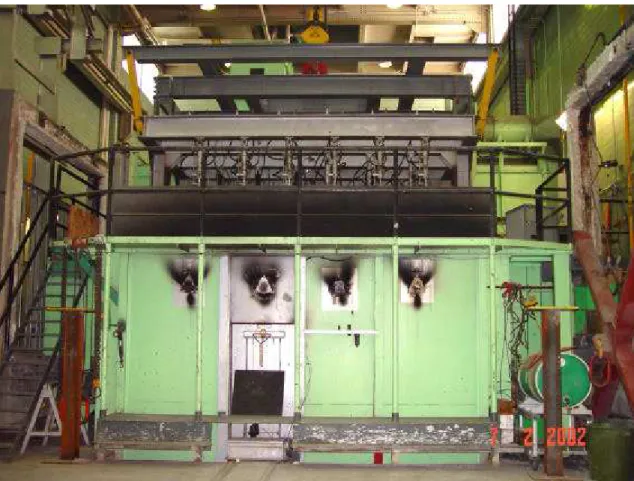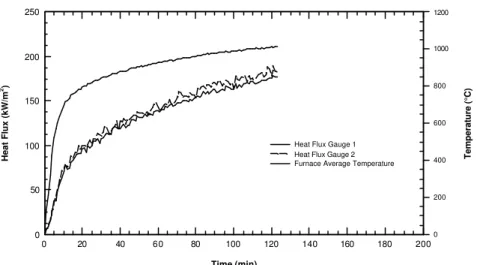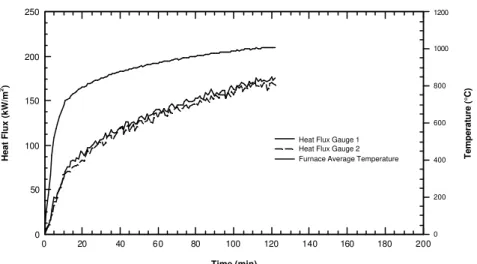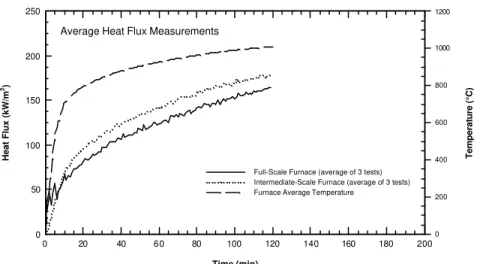Publisher’s version / Version de l'éditeur:
Vous avez des questions? Nous pouvons vous aider. Pour communiquer directement avec un auteur, consultez la
première page de la revue dans laquelle son article a été publié afin de trouver ses coordonnées. Si vous n’arrivez pas à les repérer, communiquez avec nous à PublicationsArchive-ArchivesPublications@nrc-cnrc.gc.ca.
Questions? Contact the NRC Publications Archive team at
PublicationsArchive-ArchivesPublications@nrc-cnrc.gc.ca. If you wish to email the authors directly, please see the first page of the publication for their contact information.
https://publications-cnrc.canada.ca/fra/droits
L’accès à ce site Web et l’utilisation de son contenu sont assujettis aux conditions présentées dans le site LISEZ CES CONDITIONS ATTENTIVEMENT AVANT D’UTILISER CE SITE WEB.
Fire and Materials 2003 8th International Conference [Proceedings], pp. 43-53,
2003-01-27
READ THESE TERMS AND CONDITIONS CAREFULLY BEFORE USING THIS WEBSITE. https://nrc-publications.canada.ca/eng/copyright
NRC Publications Archive Record / Notice des Archives des publications du CNRC : https://nrc-publications.canada.ca/eng/view/object/?id=db95519c-afb7-4a9a-8c83-bfe464d64c46 https://publications-cnrc.canada.ca/fra/voir/objet/?id=db95519c-afb7-4a9a-8c83-bfe464d64c46
NRC Publications Archive
Archives des publications du CNRC
This publication could be one of several versions: author’s original, accepted manuscript or the publisher’s version. / La version de cette publication peut être l’une des suivantes : la version prépublication de l’auteur, la version acceptée du manuscrit ou la version de l’éditeur.
Access and use of this website and the material on it are subject to the Terms and Conditions set forth at
Heat exposure in fire resistance furnaces: full-scale vs
intermediate-scale
Heat exposure in fire resistance furnaces: full-scale
vs intermediate-scale
Sultan, M.A.; Benichou, N.; Min, B.Y.
A version of this document is published in / Une version de ce document se trouve dans : Fire and Materials 2003 International Conference, San Francisco, Jan. 27-29, 2003, pp. 43-53
www.nrc.ca/irc/ircpubs
Heat Exposure in Fire Resistance Furnaces:
Full-scale vs Intermediate-scale
Mohamed A. Sultan and Noureddine Benichou Institute for Research in Construction National Research Council of Canada
Ottawa, Ontario, Canada
Byung Yeol Min
Korea Institute of Construction Technology 2311, Daehwa-dong, llsan-gu, Koyang-shi
Kyunggi, 411-712, Republic of Korea
ABSTRACT
This paper presents a comparison of heat exposure test results in full- and intermediate-scale fire resistance test furnaces. The results showed that for a floor furnace, the heat exposure is higher in an intermediate-scale furnace (15%) than in a full-scale furnace. Also, a comparison of the temperature measured in a castable refractory slab at 40 mm from the fire-exposed surface for both full- and intermediate-scale floor fire resistance is presented. The results showed that the temperature in the slab is slightly higher when using an intermediate-scale furnace than when using a full-scale furnace. In addition, a comparison of heat exposure in an intermediate-scale fire resistance test furnace, for both vertical (wall) and horizontal (floor) orientations is presented. The results showed that the difference (4%) in heat exposure for both orientations is insignificant.
INTRODUCTION
In recent years, fire rated floor and wall assemblies formed with new materials and construction methodologies have been increasingly used in residential buildings. To determine the fire resistance performance of these assemblies, full-scale tests are usually required. However, these tests are expensive and time consuming, and there is a need by building designers and architects, at least in the development of assemblies, to find an alternative solution. To satisfy this need, the National Research Council of Canada (NRC) has been developing simpler and less expensive tests and models to assess the fire resistance of building assemblies. Along with these efforts, NRC has just completed the construction of an intermediate-scale furnace, 1.2 m wide by 1.8 m long by 0.5 m deep, that can be used for testing loaded and unloaded wall and floor assemblies. However, to ensure that the intermediate-scale furnace can be used to reflect full-scale test results, it must be characterized. Heat exposure in fire resistance test furnaces is a critical parameter in determining the fire resistance performance of specimens. This paper presents the test results of the heat exposure characterization as well as the temperature response in a castable refractory slab using full- and intermediate-scale fire resistance floor test furnaces. Also, a comparison of heat exposure in an intermediate-scale fire resistance test furnace, for both vertical (wall) and horizontal (floor) orientations is presented. In particular, it discusses the heat exposure test results preformed at NRC on 3 repeat full-scale specimens (floor) and 6 intermediate-scale specimens (3 repeat walls and 3 repeat floors) to investigate the heat exposure in these furnaces. A number of investigations for fire exposure in standard fire resistance test furnaces were carried out by Sultan et al1 and by Cooke2. The results reported in this paper could also be used to provide information for the development of fire resistance models for floor and wall assemblies.
EXPERIMENTAL WORK
This experimental study was carried out at the National Research Council of Canada using full- and intermediate-scale fire resistance furnaces. The descriptions of the test furnaces, test specimens and heat flux sensors used to measure the fire exposure are given below.
Full-scale Floor Furnace
The full-scale fire resistance floor furnace is approximately 4 m wide by 5 m long by 3 m deep (see Figure 1). The furnace walls were made of insulated brick. The thermal properties of the fire-brick are given in Table 1. The furnace pressure measured by two pressure probes: one at 0.6 m from the test specimen and the other at 2.7 m from the test specimen pressure was slightly negative (4 to 10 Pa).
The tests were carried out by exposing the specimens to heat using the propane-fired horizontal furnace. Each specimen was sealed at the edges against the furnace using ceramic fibre blankets. The furnace temperature was measured by 9 (20 gauge) shielded thermocouples in accordance with CAN/ULC-S101-M893. The average of the 9-thermocouple temperatures was used to control the furnace. These thermocouples were located 0.3 m below the fire-exposed surface of the sample, following, as closely as possible, the CAN/ULC-S101-M89 standard time-temperature curve. This curve is similar to the ASTM E119 time-temperature curve.
Intermediate-scale Test Furnace
The intermediate-scale fire resistance floor furnace is approximately 1.2 m wide by 1.8 m long by 0.5 m deep as shown in Figure 2. The furnace walls were also made of insulated fire-brick similar to the walls of the full-scale furnace. The pressure inside the furnace was slightly negative (2 to 10 Pa) and it was measured by two pressure probes: one at 0.15 m from the test specimen and the other at 0.4 m from the test specimen.
The floor tests were carried out by exposing the specimens to heat using the propane-fired horizontal or vertical intermediate-scale furnace. Each specimen was sealed at the edges against the furnace using ceramic fibre blankets. The furnace temperature was measured by 3 (20 gauge) shielded thermocouples in accordance with CAN/ULC-S101-M89. The average of the 3-thermocouple temperatures was used to control the furnace. These thermocouples were located 0.3 m below the exposed surface of the sample, following, as closely as possible, the CAN/ULC-S101-M89 standard time-temperature curve.
Full-scale Test Specimen
The full-scale floor test specimen was a castable refractory slab, marketed as KS-4, composed of 20 rectangular slabs, 0.8 m wide by 1.2 m long by 0.15 m thick, suspended on a steel beam. The slabs were tightly butted (with ceramic sheet along their perimeters) to form a unit 4 m by 5 m. The properties of these slabs are given in Table 1.
Five 36-gauge Chromel-Alumel thermocouples were installed inside the specimens. The thermocouples were placed 40 mm from the fire-exposed surface in five slabs in such a way as to have their junctions positioned approximately at the centre and at the centres of the quarter sections of the specimen as shown in Figure 3. Two water-cooled Gardon Gauge heat flux sensors were installed flush with the specimen surface. The location of these sensors is also given in Figure 3.
Intermediate-scale Test Specimen
The intermediate-scale floor test specimen was also a castable refractory slab the same as those used in the full-scale specimen and composed of one rectangular slab, 0.8 m wide by 1.2 m long by 0.15 m thick as shown in Figure 4. The specimen was mounted in the centre of a concrete frame 1.2 m wide by 1.8 m long around the specimen. As in the full-scale specimen, five 36-gauge Chromel-Alumel thermocouples were installed inside the specimens. The thermocouples were placed 40 mm from the fire-exposed surface in five slabs in such a way as to have their junctions positioned approximately at the centre and at the centres of the quarter sections of the specimen as shown in Figure 4.
Heat Flux Sensor
The total heat exposure to the test specimen was measured by two Gardon Gauge heat flux sensors (see Figure 5), 2.5 mm diameter and 2.5 mm long copper cylinder, with an accuracy of 63%. These sensors were water cooled and mounted flush with the specimen surface at the locations shown in Figure 3 (full-scale) and Figure 4 (intermediate-scale). The source of water flow was maintained at 40°C during the entire test as specified by the manufacturer of the sensors.
RESULTS AND DISCUSSION
The heat exposure measurements in 6 intermediate-scale fire resistance tests (3 using the wall furnace and 3 using the floor furnace) and in 3 full-scale floor tests, as well as the temperature responses inside the test specimens, are given in Figures 6 to 17.
Effect of Furnace Size
To study the effect of furnace size on the heat exposure in full- and intermediate-scale fire resistance floor test furnaces, 6 tests were conducted: 3 repeat tests using the full-scale furnace and 3 repeat tests using the intermediate-scale furnace. The duration of each test was two hours and measurements were recorded every minute. The heat exposure results for 3 tests using the intermediate-scale-scale floor furnace are presented in Figures 6 to 8. Also, the heat exposure results for 3 tests using the full-scale floor furnace are presented in Figures 9 to 11. A comparison of the average heat exposure of 3 repeat tests in full- and intermediate-scale furnaces is plotted in Figure 15. Also, a comparison of the average temperature response inside the test specimen at 40 mm from the fire-exposed surface of 3 repeat tests is plotted in Figure 16. The results showed that, when either the full-scale or the intermediate-scale fire resistance furnace is heated up using the CAN/ULC-S101-89 or ASTM E119 time-temperature curve, the heat exposure in the intermediate-scale furnace is approximately 15% higher than in the full-scale furnace. Also, the average temperature distribution is slightly higher in the specimens tested in the intermediate-scale furnace than in the specimens tested in the full-scale furnace. These results suggest that the effect of furnace size on heat exposure is somewhat significant. Generally, the heat received by a test specimen in fire resistance test furnaces is by radiation and convection. The radiative part is much greater than the convective part. In the full-scale furnaces, the convective heat occurs by natural convection while, in the smaller size furnaces, it occurs by forced convection. Heat transfer by forced convection is greater than by natural convection. As the furnace size increases, the convective heat to the specimen decreases and this may explain why the heat exposure in an intermediate-scale furnace is higher than in a full-scale furnace. For fire exposure, testing an assembly in an intermediate-scale furnace will provide a conservative performance compared to a full-scale furnace.
Effect of Furnace Orientation (Vertical vs Horizontal)
To study the effect of furnace orientation (vertical vs horizontal) in an intermediate-scale fire resistance floor test furnace, 6 tests were conducted: 3 repeat tests with the furnace in the vertical position and 3 other repeat tests with the furnace in the horizontal position. The heat exposure results for the furnace in the horizontal position and in the vertical position are shown in Figures 6 to 8 and Figures 12 to 14, respectively. A comparison of the heat exposure to a test specimen for the furnace in the horizontal position and in the vertical position is plotted in Figure 17. The results showed that, when an intermediate-scale fire resistance furnace (1.2 m wide by 1.8 m long by 0.5 m deep) is heated up using the CAN/ULC-S101-89 or ASTM E119 time-temperature curve, the heat exposure to a test specimen in a furnace oriented horizontally is slightly higher (4%) than in a furnace oriented vertically. The difference in heat exposure is considered to be insignificant.
CONCLUSIONS
This paper discussed the effect of furnace size and furnace orientation on the heat exposure in fire resistance test furnaces. Based on the results mentioned above, the following key trends can be highlighted:
1. The heat exposure in the intermediate-scale fire resistance furnace, 1.2 wide by 1.8 m long by 0.5 m deep, is slightly higher than in the full-scale furnace, 4 m wide by 5 m long by 3 m deep.
2. For the intermediate-scale furnace, 1.2 m wide by 1.8 long by 0.5 m deep, the effect of furnace orientation, whether vertical (wall) or horizontal (floor), on the heat exposure to the test specimen is insignificant.
ACKNOWLEDGEMENTS
The authors wish to thank Jocelyn Henrie, Yves Seguin, Roch Monette and Patrice Leroux for their help in conducting the high quality experimental work.
REFERENCES
1. Sultan, M.A., Harmathy, T.Z. and Mehaffey, J.R., “Heat Transmission in Fire Test Furnaces”, Fire and Materials, Vol. 10, No. 2, 1986.
2. Cooke, G.M.E, “Can Harmonization of Fire Resistance Furnaces be Achieved by Plate Thermometers Control? ”, Proceedings, 4th IAFSS, Ottawa, Canada, 1994.
3. CAN/ULS-S101-M89, “Standard Methods of Fire Endurance Tests of Building Construction and Materials”, ULC, Scarborough, Ontario, Canada, 1989.
4. ASTM E119-88, “Standard Methods of Fire Tests of Building Constructions and Materials”, ASTM, Philadelphia, PA, 1995.
Table 1 Thermal Properties of Furnace Lining and Specimen Materials
Furnace Lining Material Fire-brick
Specimen Material Castable Refractory Slab
Thermal Conductivity (W m -1K –1) 1.15 0.9 Specific Heat (J kg -1 K -1) 900 1000 Density (kg m-3 ) 2600 2085
Figure 1 NRC Full-scale Floor Furnace
Figure 3 Heat Flux Sensor and Thermocouple Locations (Full-scale Test Specimen)
Figure 4 Heat Flux Sensor and Thermocouple Locations (Intermediate-scale Test Specimen)
Figure 5 Water Cooled Gardon Gauge Heat Flux Sensor 5 m
4 m
heat flux sensor
thermocouple
0.8 m
1.2 m
thermocouple
heat flux sensor
Time (min) 0 20 40 60 80 100 120 140 160 180 200 Heat Flux (kW/m 2) 0 50 100 150 200 250 Temperature (°C) 0 200 400 600 800 1000 1200
Heat Flux Gauge 1 Heat Flux Gauge 2 Furnace Average Temperature
Figure 6 Heat Exposure Measurement in Intermediate-scale Floor Furnace (Test No. 1)
Time (min) 0 20 40 60 80 100 120 140 160 180 200 Heat Flux (kW/m 2) 0 50 100 150 200 250 Temperature (°C) 0 200 400 600 800 1000 1200
Heat Flux Gauge 1 Heat Flux Gauge 2 Furnace Average Temperature
Figure 7 Heat Exposure Measurement in Intermediate-scale Floor Furnace (Test No. 2)
Time (min) 0 20 40 60 80 100 120 140 160 180 200 Heat Flux (kW/m 2) 0 50 100 150 200 250 Temperature (°C) 0 200 400 600 800 1000 1200
Heat Flux Gauge 1 Heat Flux Gauge 2 Furnace Average Temperature
Time (min) 0 20 40 60 80 100 120 140 160 180 200 Heat Flux (kW/m 2) 0 50 100 150 200 250 Temperature (°C) 0 200 400 600 800 1000 1200
Heat Flux Gauge 1 Heat Flux Gauge 2 Furnace Average Temperature
Figure 9 Heat Exposure Measurement in Full-scale Floor Furnace (Test No. 1)
Time (min) 0 20 40 60 80 100 120 140 160 180 200 Heat Flux (kW/m 2) 0 50 100 150 200 250 Temperature (°C) 0 200 400 600 800 1000 1200
Heat Flux Gauge 1 Heat Flux Gauge 2 Furnace Average Temperature
Figure 10 Heat Exposure Measurement in Full-scale Floor Furnace (Test No. 2)
Time (min) 0 20 40 60 80 100 120 140 160 180 200 Heat Flux (kW/m 2) 0 50 100 150 200 250 Temperature (°C) 0 200 400 600 800 1000 1200
Heat Flux Gauge 1 Heat Flux Gauge 2 Furnace Average Temperature
Time (min) 0 20 40 60 80 100 120 140 160 180 200 Heat Flux (kW/m 2) 0 50 100 150 200 250 Temperature (°C) 0 200 400 600 800 1000 1200
Heat Flux Gauge 1 Heat Flux Gauge 2 Furnace Average Temperature
Figure 12 Heat Exposure Measurements in Intermediate-scale Wall Furnace (Test No. 1)
Time (min) 0 20 40 60 80 100 120 140 160 180 200 Heat Flux (kW/m 2) 0 50 100 150 200 250 Temperature (°C) 0 200 400 600 800 1000 1200
Heat Flux Gauge 1 Heat Flux Gauge 2 Furnace Average Temperature
Figure 13 Heat Exposure Measurements in Intermediate-scale Wall Furnace (Test No. 2)
Time (min) 0 20 40 60 80 100 120 140 160 180 200 Heat Flux (kW/m 2) 0 50 100 150 200 250 Temperature (°C) 0 200 400 600 800 1000 1200
Heat Flux Gauge 1 Heat Flux Gauge 2 Furnace Average Temperature
Time (min) 0 20 40 60 80 100 120 140 160 180 200 Heat Flux (kW/m 2) 0 50 100 150 200 250 Temperature (°C) 0 200 400 600 800 1000 1200
Full-Scale Furnace (average of 3 tests) Intermediate-Scale Furnace (average of 3 tests) Furnace Average Temperature
Average Heat Flux Measurements
Figure 15 Comparison of Heat Exposure in Intermediate-scale vs Full-scale Floor Furnace
Time (min) 0 20 40 60 80 100 120 140 160 180 200 Temperature (°C) 0 100 200 300 400 500 600 700
Full-Scale Furnace (average of 3 tests) Intermediate-Scale Furnace (average of 3 tests)
Average Slab Temperatures
Figure 16 Comparison of Temperature at 40 mm (Intermediate-scale vs Full-scale)
Time (min) 0 20 40 60 80 100 120 140 160 180 200 Heat Flux (kW/m 2) 0 50 100 150 200 250 Temperature (°C) 0 200 400 600 800 1000 1200
Hirizontal Position (average of 3 tests) Vertical Position (average of 3 tests) Furnace Average Temperature






